A Methodology to Predict the Fatigue Life under Multi-Axial Loading of Carbon Fiber-Reinforced Polymer Composites Considering Anisotropic Mechanical Behavior
Abstract
:1. Introduction
2. Materials and Methods
2.1. Materials and Experimental Methods
2.2. Numerical Analysis Methods
2.3. Fatigue Life Prediction Model
3. Results
3.1. Static and Fatigue Mechanical Properties
3.2. Numerical Analysis Results
3.3. Fatigue Life Prediction
4. Discussion
5. Concluding Remarks
- The tensile strength of a material increases as a load is applied in the same direction as the fiber orientation. In addition, the PA6-CF shows a more significant anisotropy than the PP-CF.
- A one-way coupled injection-structural analysis model was developed, and fiber orientation along the polymer flow was considered through XCT photography and the Ramberg–Osgood model.
- The semi-empirical fatigue life prediction model based on the energy function showed high prediction accuracy of PA6-CF and PP-CF with a correlation coefficient of 0.9813 and 0.9797, respectively.
- The developed fatigue life prediction methodology allows designers to reduce trial and error when designing products of complex geometries composed of injection molded short CFRPs and effectively predict fatigue life.
Author Contributions
Funding
Institutional Review Board Statement
Informed Consent Statement
Data Availability Statement
Conflicts of Interest
References
- Bidaine, B.; Adam, L.; Assaker, R.; Robert, G.; Moulinjeune, O.; Perret, L.; Charrier, P.; Taveau, D.; Chauvet, L.; Haouala, S.; et al. Fiber Reinforced Plastic Durability: Nonlinear Multi-Scale Modeling for Structural Part Life Predictions. Available online: https://saemobilus.sae.org/content/2019-26-0278/ (accessed on 30 January 2023). [CrossRef]
- Kim, J.H.; Jung, Y.H.; Lambiase, F.; Moon, Y.H.; Ko, D.C. Novel Approach toward the Forming Process of CFRP Reinforcement with a Hot Stamped Part by Prepreg Compression Molding. Materials 2022, 15, 4743. [Google Scholar] [CrossRef]
- Kim, J.H.; Song, B.K.; Min, K.J.; Choi, J.C.; Eun, H.S. Optimizing Heat Treatment Conditions for Measuring CFRP and GFRP Resin Impregnation. Materials 2022, 15, 8182. [Google Scholar] [CrossRef] [PubMed]
- Zhuge, P.; Tao, G.; Wang, B.; Jie, Z.; Zhang, Z. Effects of High Temperatures on the Performance of Carbon Fiber Reinforced Polymer (CFRP) Composite Cables Protected with Fire-Retardant Materials. Materials 2022, 15, 4696. [Google Scholar] [CrossRef] [PubMed]
- Mandell, J.F. Fatigue Behavior of Short Fiber Composite Materials, 2nd ed.; Elsevier Science Publishers B.V.: Amsterdam, The Netherlands, 1991; Volume 4. [Google Scholar]
- Phelps, J. Processing-Microstructure Models for Short- and Long-Fiber Thermoplastic Composites; University of Illinois at Urbana-Champaign: Urbana, IL, USA, 2009; p. 198. [Google Scholar]
- Qureshi, H.J.; Saleem, M.U.; Khurram, N.; Ahmad, J.; Amin, M.N.; Khan, K.; Aslam, F.; Al Fuhaid, A.F.; Arifuzzaman, M. Investigation of CFRP Reinforcement Ratio on the Flexural Capacity and Failure Mode of Plain Concrete Prisms. Materials 2022, 15, 7248. [Google Scholar] [CrossRef] [PubMed]
- Gillani, F.; Zahid, T.; Bibi, S.; Khan, R.S.U.; Bhutta, M.R.; Ghafoor, U. Parametric Optimization for Quality of Electric Discharge Machined Profile by Using Multi-Shape Electrode. Materials 2022, 15, 2205. [Google Scholar] [CrossRef]
- Gillani, F.; Khan, M.Z.; Shah, O.R. Sensitivity Analysis of Reinforced Aluminum Based Metal Matrix Composites. Materials 2022, 15, 4225. [Google Scholar] [CrossRef]
- Pan, Y.; Yan, D. Study on the Durability of GFRP Bars and Carbon/Glass Hybrid Fiber Reinforced Polymer (HFRP) Bars Aged in Alkaline Solution. Compos. Struct. 2021, 261, 113285. [Google Scholar] [CrossRef]
- Xian, G.; Guo, R.; Li, C.; Wang, Y. Mechanical Performance Evolution and Life Prediction of Prestressed CFRP Plate Exposed to Hygrothermal and Freeze-Thaw Environments. Compos. Struct. 2022, 293, 115719. [Google Scholar] [CrossRef]
- Zhou, P.; Tian, J.; Li, C.; Tang, Z. Comparative Study of Durability Behaviors of Thermoplastic Polypropylene and Thermosetting Epoxy Exposed to Elevated Temperature, Water Immersion and Sustained Bending Loading. Polymers 2022, 14, 2953. [Google Scholar] [CrossRef]
- Shao, Y.; Okubo, K.; Fujii, T.; Shibata, O.; Fujita, Y. Effect of Matrix Properties on the Fatigue Damage Initiation and Its Growth in Plain Woven Carbon Fabric Vinylester Composites. Compos. Sci. Technol. 2014, 104, 125–135. [Google Scholar] [CrossRef]
- Harris, B. Fatigue in Composites. Harris, B., Ed.; Woodhead Publishing Ltd.: Cambridge, UK, 2003; ISBN 9781626239777. [Google Scholar]
- Rezaei, F.; Yunus, R.; Ibrahim, N.A. Effect of Fiber Length on Thermomechanical Properties of Short Carbon Fiber Reinforced Polypropylene Composites. Mater. Des. 2009, 30, 260–263. [Google Scholar] [CrossRef]
- Shao-Yun, F.; Bernd, L. Effects of Fiber Length and Fiber Orientation Distributions on the Tensile Strength of Short-Fiber-Reinforced Polymers. Compos. Sci. Technol. 1996, 56, 1179–1190. [Google Scholar]
- Bernasconi, A.; Davoli, P.; Basile, A.; Filippi, A. Effect of Fibre Orientation on the Fatigue Behaviour of a Short Glass Fibre Reinforced Polyamide-6. Int. J. Fatigue 2007, 29, 199–208. [Google Scholar] [CrossRef]
- Fu, S.Y.; Lauke, B.; Mäder, E.; Yue, C.Y.; Hu, X. Tensile Properties of Short-Glass-Fiber- and Short-Carbon-Fiber-Reinforced Polypropylene Composites. Compos. Part A Appl. Sci. Manuf. 2000, 31, 1117–1125. [Google Scholar] [CrossRef]
- Noda, K.; Takahara, A.; Kajiyama, T. Fatigue Failure Mechanisms of Short Glass-Fiber Reinforced Nylon 66 Based on Nonlinear Dynamic Viscoelastic Measurement. Polymer 2001, 42, 5803–5811. [Google Scholar] [CrossRef]
- Meneghetti, G.; Ricotta, M.; Lucchetta, G.; Carmignato, S. An Hysteresis Energy-Based Synthesis of Fully Reversed Axial Fatigue Behaviour of Different Polypropylene Composites. Compos. Part B Eng. 2014, 65, 17–25. [Google Scholar] [CrossRef]
- Panin, S.V.; Bogdanov, A.A.; Eremin, A.V.; Buslovich, D.G.; Alexenko, V.O. Estimating Low-and High-Cyclic Fatigue of Polyimide-CF-PTFE Composite through Variation of Mechanical Hysteresis Loops. Materials 2022, 15, 4656. [Google Scholar] [CrossRef]
- Zago, A.; Springer, G.S. Fatigue Lives of Short Fiber Reinforced Thermoplastics Parts. J. Reinf. Plast. Compos. 2001, 20, 606–620. [Google Scholar] [CrossRef]
- Brunbauer, J.; Mösenbacher, A.; Guster, C.; Pinter, G. Fundamental Influences on Quasistatic and Cyclic Material Behavior of Short Glass Fiber Reinforced Polyamide Illustrated on Microscopic Scale. J. Appl. Polym. Sci. 2014, 131, 1–14. [Google Scholar] [CrossRef]
- Tseng, H.C.; Chang, Y.J.; Wang, T.C.; Hsu, C.H.; Chang, R.Y. Three Dimensional Predictions of Fiber Orientation for Injection Molding of Long Fiber Reinforced Thermoplastics. In Proceedings of the SPE ACCE Conference, Michigang, AT, USA, 11–13 September 2013; Volume 2, pp. 1051–1058. [Google Scholar]
- De Monte, M.; Moosbrugger, E.; Quaresimin, M. Influence of Temperature and Thickness on the Off-Axis Behaviour of Short Glass Fibre Reinforced Polyamide 6.6—Cyclic Loading. Compos. Part A Appl. Sci. Manuf. 2010, 41, 1368–1379. [Google Scholar] [CrossRef]
- Amorim, L.; Santos, A.; Nunes, J.P.; Viana, J.C. Bioinspired Approaches for Toughening of Fibre Reinforced Polymer Composites. Mater. Des. 2021, 199, 109336. [Google Scholar] [CrossRef]
- Klimkeit, B.; Nadot, Y.; Castagnet, S.; Nadot-Martin, C.; Dumas, C.; Bergamo, S.; Sonsino, C.M.; Büter, A. Multi-axial Fatigue Life Assessment for Reinforced Polymers. Int. J. Fatigue 2011, 33, 766–780. [Google Scholar] [CrossRef]
- Shaharuddin, S.I.S.; Salit, M.S.; Edi Syams, Z. A Review of the Effect of Moulding Parameters on the Performance of Polymeric Composite Injection Moulding. Turkish J. Med. Sci. 2006, 30, 23–34. [Google Scholar] [CrossRef]
- Mortazavian, S.; Fatemi, A. Effects of Fiber Orientation and Anisotropy on Tensile Strength and Elastic Modulus of Short Fiber Reinforced Polymer Composites. Compos. Part B Eng. 2015, 72, 116–129. [Google Scholar] [CrossRef]
- Vincent, M.; Giroud, T.; Clarke, A.; Eberhardt, C. Description and Modeling of Fiber Orientation in Injection Molding of Fiber Reinforced Thermoplastics. Polymer 2005, 46, 6719–6725. [Google Scholar] [CrossRef]
- Advani, S.G.; Tucker, C.L. The Use of Tensors to Describe and Predict Fiber Orientation in Short Fiber Composites. J. Rheol. 1987, 31, 751–784. [Google Scholar] [CrossRef]
- Kanters, M.J.W.; Douven, L.F.A.; Savoyat, P. Fatigue Life Prediction of Injection Moulded Short Glass Fiber Reinforced Plastics. Procedia Struct. Integr. 2019, 19, 698–710. [Google Scholar] [CrossRef]
- Magino, N.; Köbler, J.; Andrä, H.; Welschinger, F.; Müller, R.; Schneider, M. A Space-Time Upscaling Technique for Modeling High-Cycle Fatigue-Damage of Short-Fiber Reinforced Composites. Compos. Sci. Technol. 2022, 222, 109340. [Google Scholar] [CrossRef]
- Ivan, R.; Sorgato, M.; Zanini, F.; Lucchetta, G. Improving Numerical Modeling Accuracy for Fiber Orientation and Mechanical Properties of Injection Molded Glass Fiber Reinforced Thermoplastics. Materials 2022, 15, 4720. [Google Scholar] [CrossRef]
- Mortazavian, S.; Fatemi, A. Fatigue Behavior and Modeling of Short Fiber Reinforced Polymer Composites Including Anisotropy and Temperature Effects. Int. J. Fatigue 2015, 77, 12–27. [Google Scholar] [CrossRef]
- Gude, M.; Hufenbach, W.; Koch, I.; Protz, R. Fatigue Failure Criteria and Degradation Rules for Composites under Multi-axial Loading. Mech. Compos. Mater. 2006, 42, 443–450. [Google Scholar] [CrossRef]
- Russo, A.; Sellitto, A.; Curatolo, P.; Acanfora, V.; Saputo, S.; Riccio, A. A Robust Numerical Methodology for Fatigue Damage Evolution Simulation in Composites. Materials 2021, 14, 3348. [Google Scholar] [CrossRef]
- Zhang, X.; Zhu, H.; Lv, Z.; Zhao, X.; Wang, J.; Wang, Q. Investigation of Biaxial Properties of CFRP with the Novel-Designed Cruciform Specimens. Materials 2022, 15, 7034. [Google Scholar] [CrossRef]
- Tanaka, K.; Oharada, K.; Yamada, D.; Shimizu, K. Fatigue Crack Propagation in Short-Carbon-Fiber Reinforced Plastics Evaluated Based on Anisotropic Fracture Mechanics. Int. J. Fatigue 2016, 92, 415–425. [Google Scholar] [CrossRef]
- Mortazavian, S.; Fatemi, A. Fatigue of Short Fiber Thermoplastic Composites: A Review of Recent Experimental Results and Analysis. Int. J. Fatigue 2017, 102, 171–183. [Google Scholar] [CrossRef]
- Ahmadifar, M.; Benfriha, K.; Shirinbayan, M. Thermal, Tensile and Fatigue Behaviors of the PA6, Short Carbon Fiber-Reinforced PA6, and Continuous Glass Fiber-Reinforced PA6 Materials in Fused Filament Fabrication (FFF). Polymers 2023, 15, 507. [Google Scholar] [CrossRef] [PubMed]
- Belmonte, E.; De Monte, M.; Hoffmann, C.J.; Quaresimin, M. Damage Initiation and Evolution in Short Fiber Reinforced Polyamide under Fatigue Loading: Influence of Fiber Volume Fraction. Compos. Part B Eng. 2017, 113, 331–341. [Google Scholar] [CrossRef]
- Tanaka, K.; Kitano, T.; Egami, N. Effect of Fiber Orientation on Fatigue Crack Propagation in Short-Fiber Reinforced Plastics. Eng. Fract. Mech. 2014, 123, 44–58. [Google Scholar] [CrossRef]
- Coffin, L.F.J. A Study of the Effects of Cyclic Thermal Stresses on a Ductile Metal. TraIns. Am. Soc. Mech. Eng. 1954, 76, 931–950. [Google Scholar] [CrossRef]
- Smith, K.N.; Topper, T.H. A Stress-Strain Function for the Fatigue of Metals. J. Mater. 1970, 5, 767–778. [Google Scholar]
- Choi, J.; Quagliato, L.; Shin, J.; Kim, N. Investigation on the Static and Cyclic Anisotropic Mechanical Behavior of Polychloroprene Rubber (CR) Reinforced with Tungsten Nano-Particles. Eng. Fract. Mech. 2020, 235, 107183. [Google Scholar] [CrossRef]
- Choi, J.; Quagliato, L.; Lee, S.; Shin, J.; Kim, N. Multi-axial Fatigue Life Prediction of Polychloroprene Rubber (CR) Reinforced with Tungsten Nano-Particles Based on Semi-Empirical and Machine Learning Models. Int. J. Fatigue 2021, 145, 106136. [Google Scholar] [CrossRef]
- Branco, R.; Costa, J.D.; Antunes, F.V. Fatigue Behaviour and Life Prediction of Lateral Notched Round Bars under Bending-Torsion Loading. Eng. Fract. Mech. 2014, 119, 66–84. [Google Scholar] [CrossRef]
- Mi, C.; Huang, Z.; Wang, H.; Zhang, D.; Xiong, T.; Jian, H.; Tang, J.; Yu, J. An Energy-Based Method for Lifetime Assessment on High-Strength-Steel Welded Joints under Different Pre-Strain Levels. Materials 2022, 15, 4558. [Google Scholar] [CrossRef]
- Tomažinčič, D.; Klemenc, J. Estimate of Coffin–Manson Curve Shift for the Porous Alloy AlSi9Cu3 Based on Numerical Simulations of a Porous Material Carried Out by Using the Taguchi Array. Materials 2022, 15, 2269. [Google Scholar] [CrossRef] [PubMed]
- Lopez-Crespo, P.; Moreno, B.; Lopez-Moreno, A.; Zapatero, J. Study of Crack Orientation and Fatigue Life Prediction in Biaxial Fatigue with Critical Plane Models. Eng. Fract. Mech. 2015, 136, 115–130. [Google Scholar] [CrossRef]
- Ghorbani, H.; Chakherlou, T.N.; Taghizadeh, H. On the Estimation of Fatigue Life in Bolt Clamped Al-Alloy 2024-T3 Plates. Eng. Fract. Mech. 2016, 164, 74–92. [Google Scholar] [CrossRef]
- Chen, Q.; Guo, H.; Avery, K.; Su, X.; Kang, H. Fatigue Performance and Life Estimation of Automotive Adhesive Joints Using a Fracture Mechanics Approach. Eng. Fract. Mech. 2017, 172, 73–89. [Google Scholar] [CrossRef]
- Choi, J.; Choi, J.; Lee, K.; Hur, N.; Kim, N. Fatigue Life Prediction Methodology of Hot Work Tool Steel Dies for High-Pressure Die Casting Based on Thermal Stress Analysis. Metals 2022, 12, 1744. [Google Scholar] [CrossRef]
- Sonsino, C.M.; Moosbrugger, E. Fatigue Design of Highly Loaded Short-Glass-Fibre Reinforced Polyamide Parts in Engine Compartments. Int. J. Fatigue 2008, 30, 1279–1288. [Google Scholar] [CrossRef]
- Wang, J.; O’Gara, J.F.; Tucker, C.L. An Objective Model for Slow Orientation Kinetics in Concentrated Fiber Suspensions: Theory and Rheological Evidence. J. Rheol. 2008, 52, 1179–1200. [Google Scholar] [CrossRef]
- Fröhler, B.; Weissenböck, J.; Schiwarth, M.; Kastner, J.; Heinzl, C. Open_iA: A Tool for Processing and Visual Analysis of Industrial Computed Tomography Datasets. J. Open Source Softw. 2019, 4, 1185. [Google Scholar] [CrossRef]
- Manson, S.S. Fatigue: A Complex Subject—Some Simple Approximations. Soc. Exp. Stress Anal. 1964, 15, 1–23. [Google Scholar] [CrossRef] [Green Version]
- Basquin, O.H. The Exponential Law of Endurance Tests. In Proceedings of the American Society for Testing and Materials Proceedings, Atlantci City, NJ, USA, 28 June–2 July 1910; pp. 625–630. [Google Scholar]
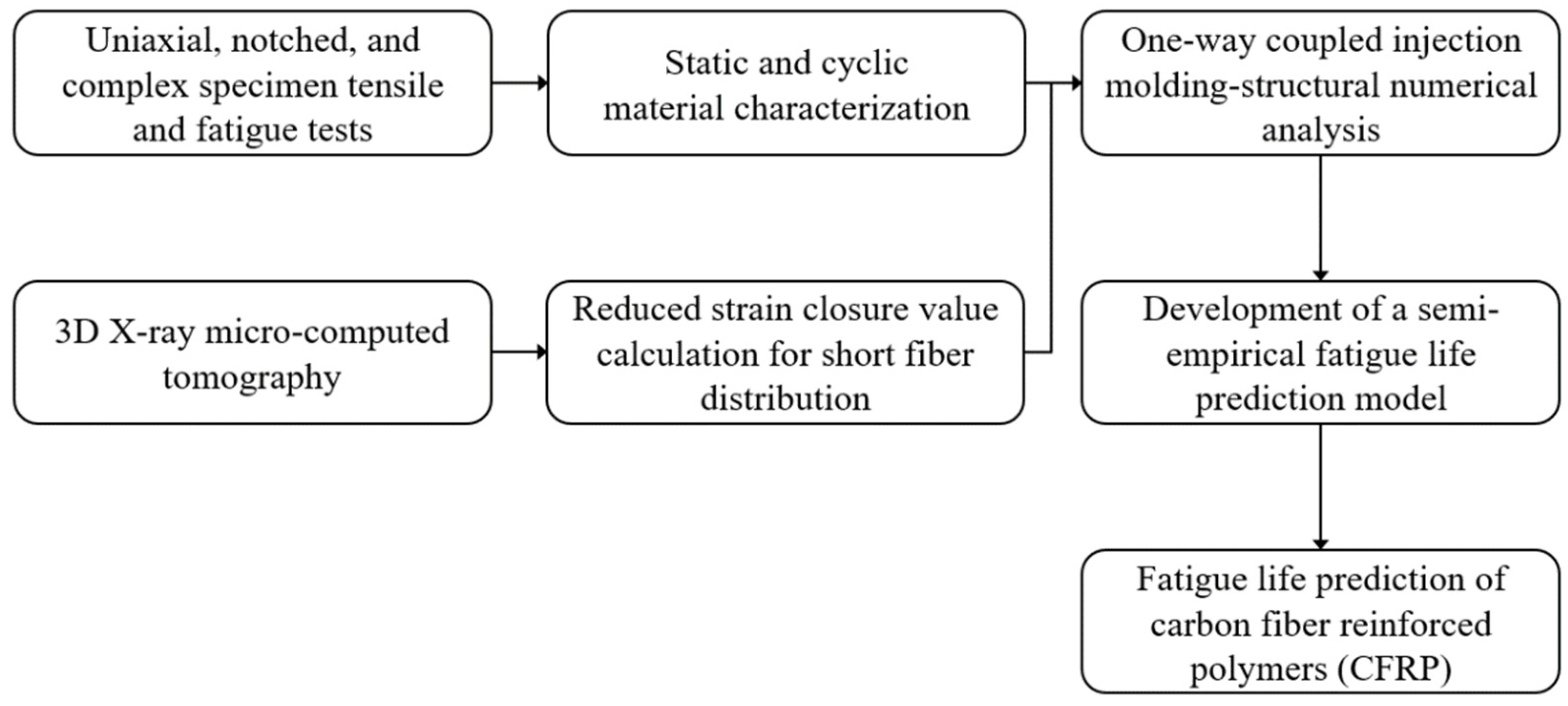

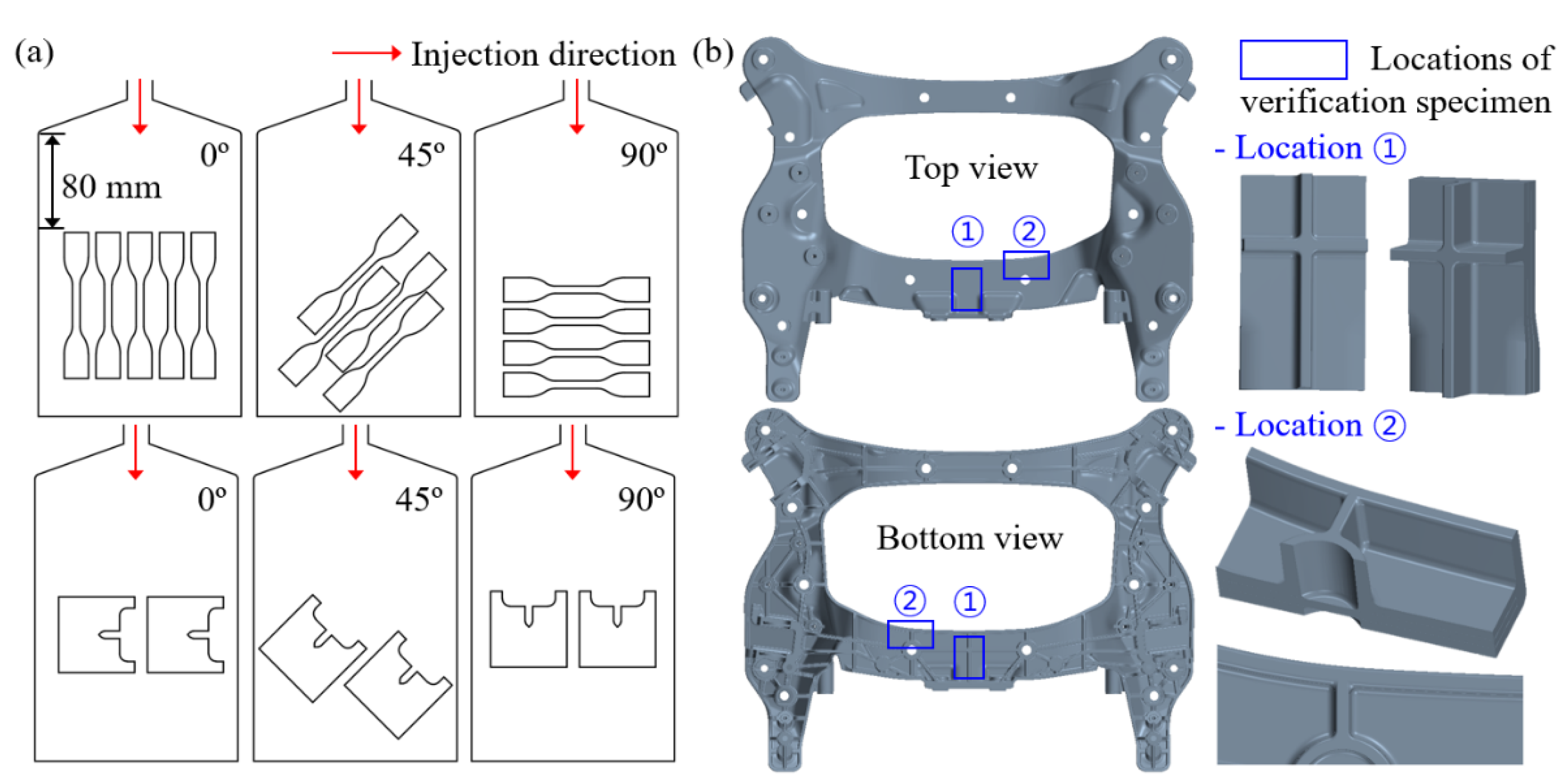
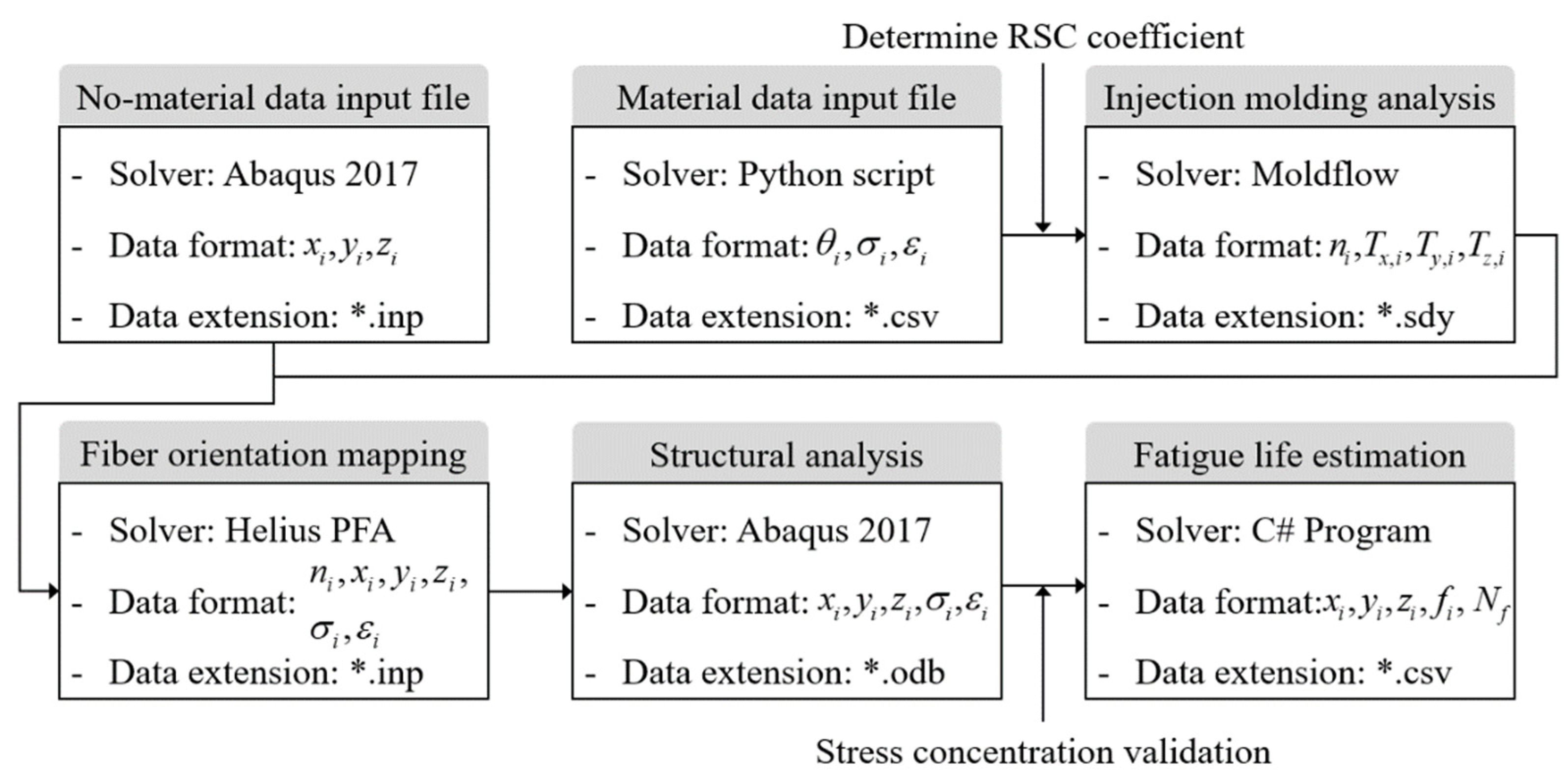
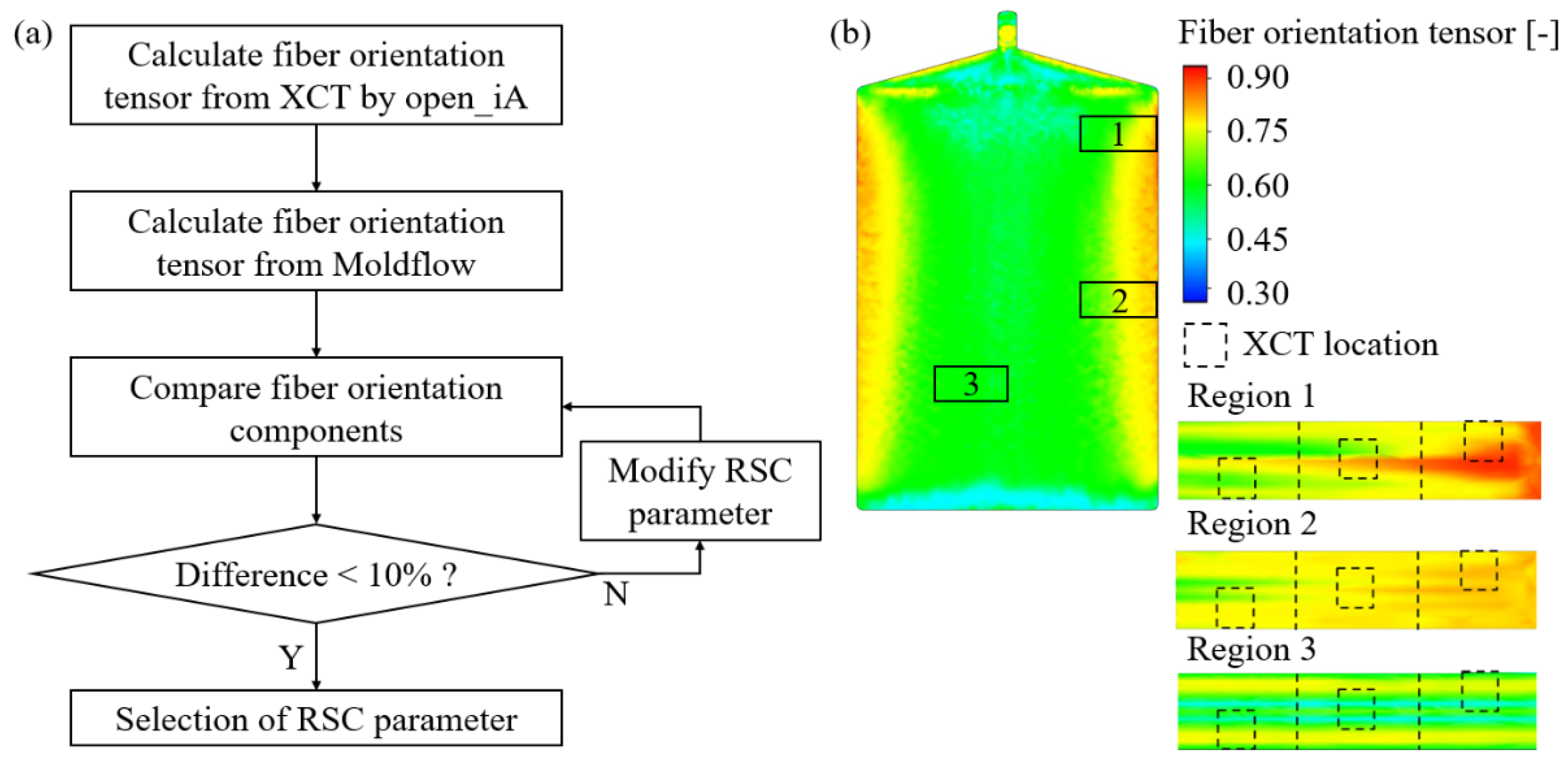
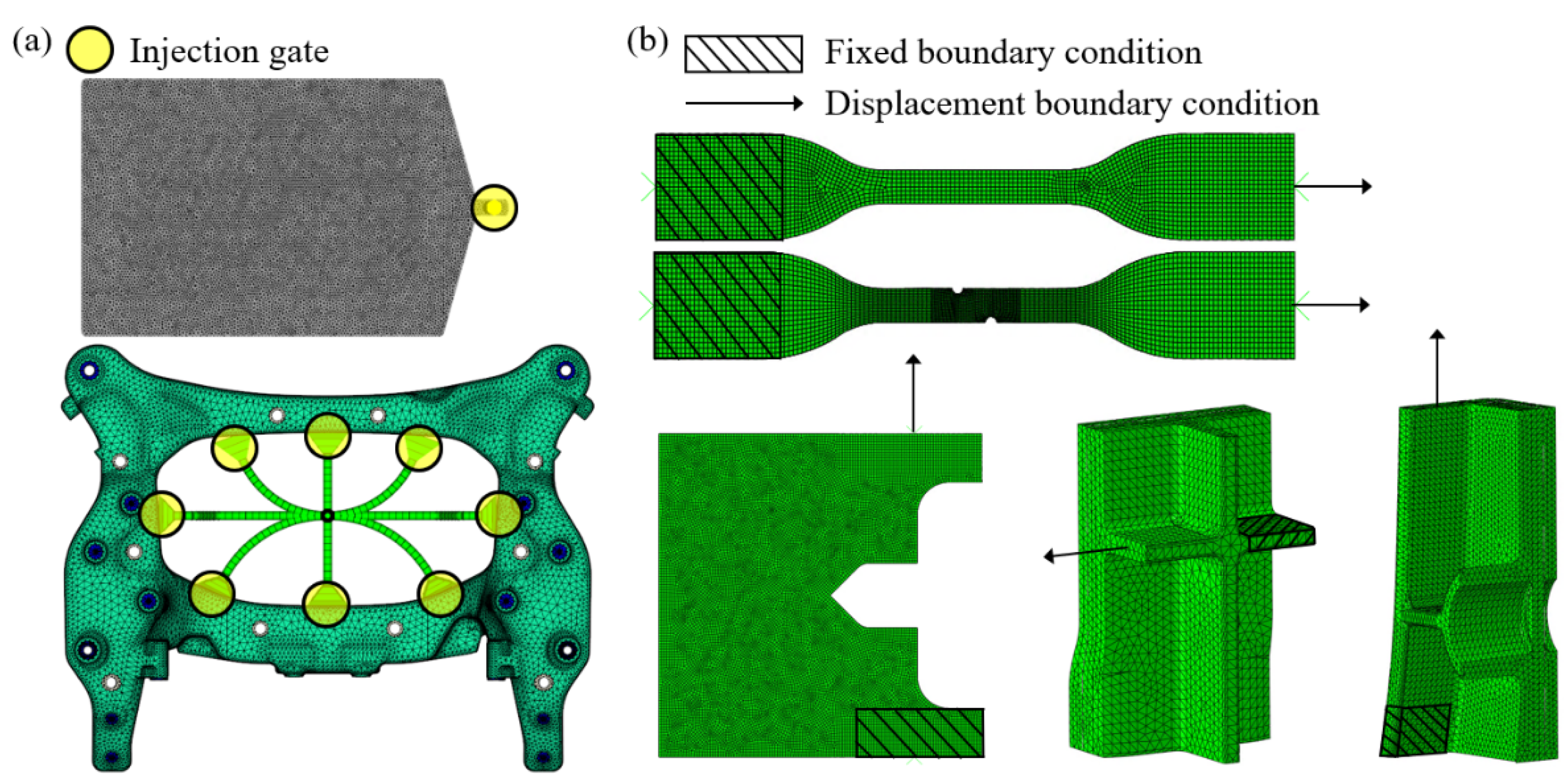
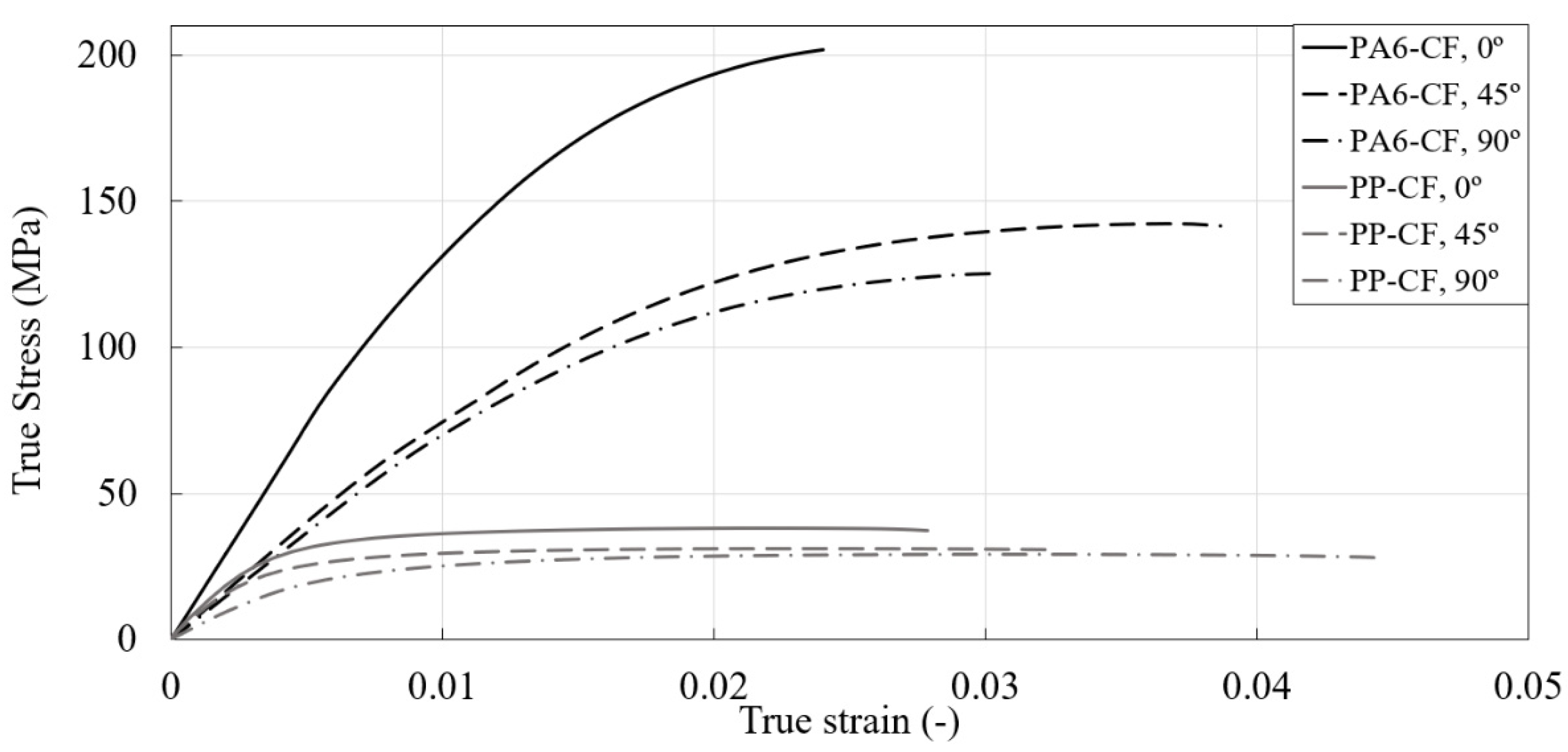

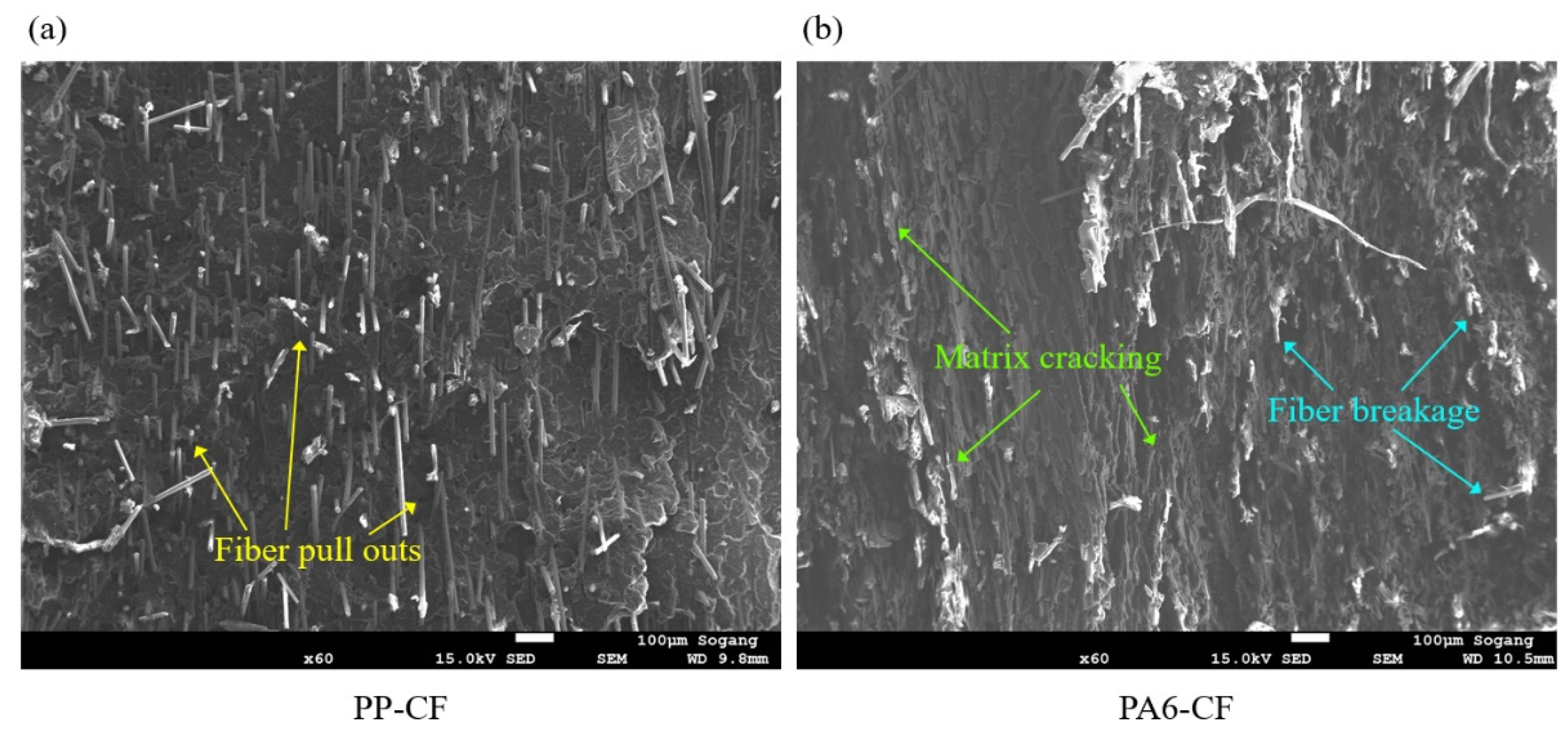
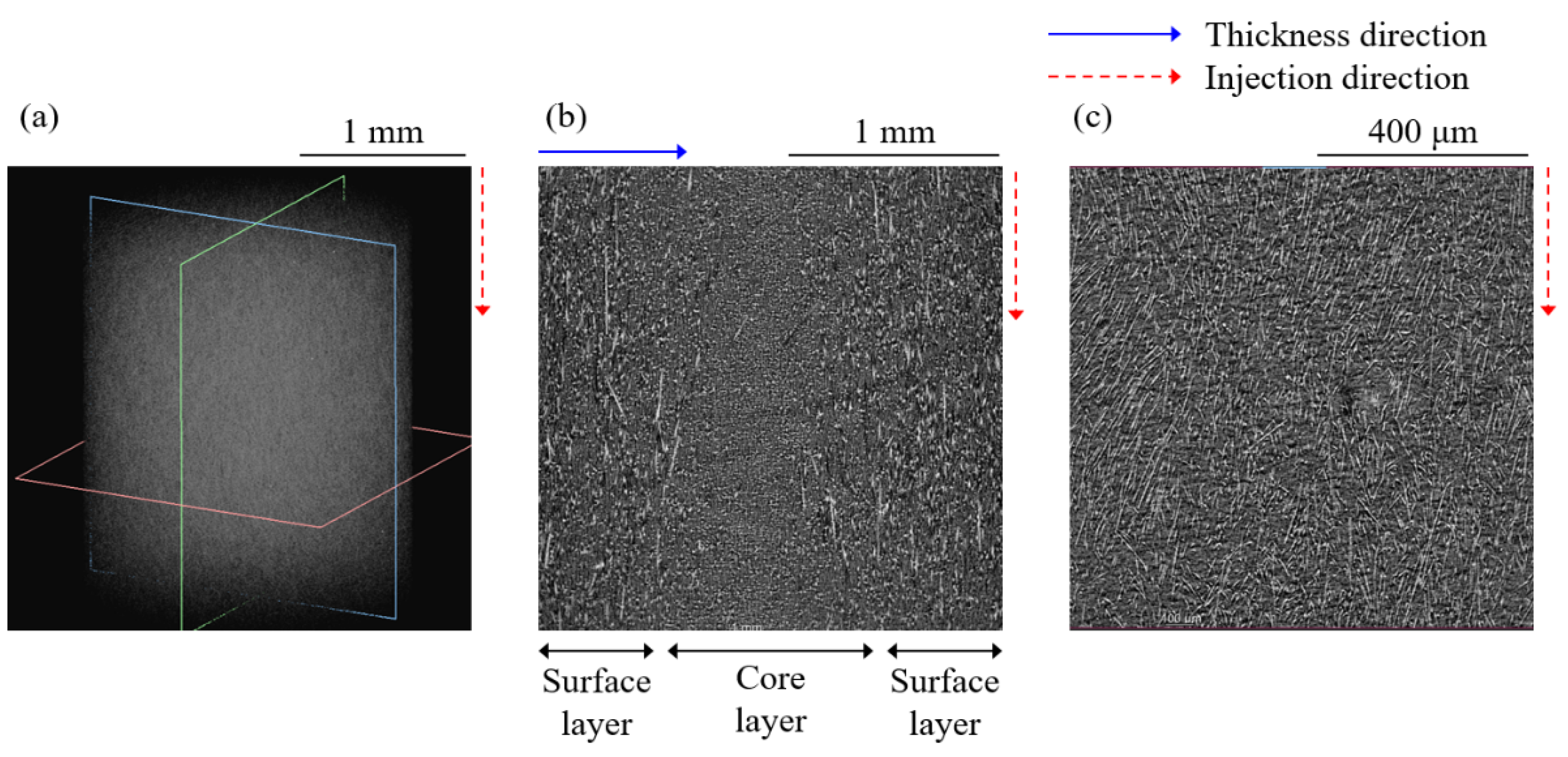
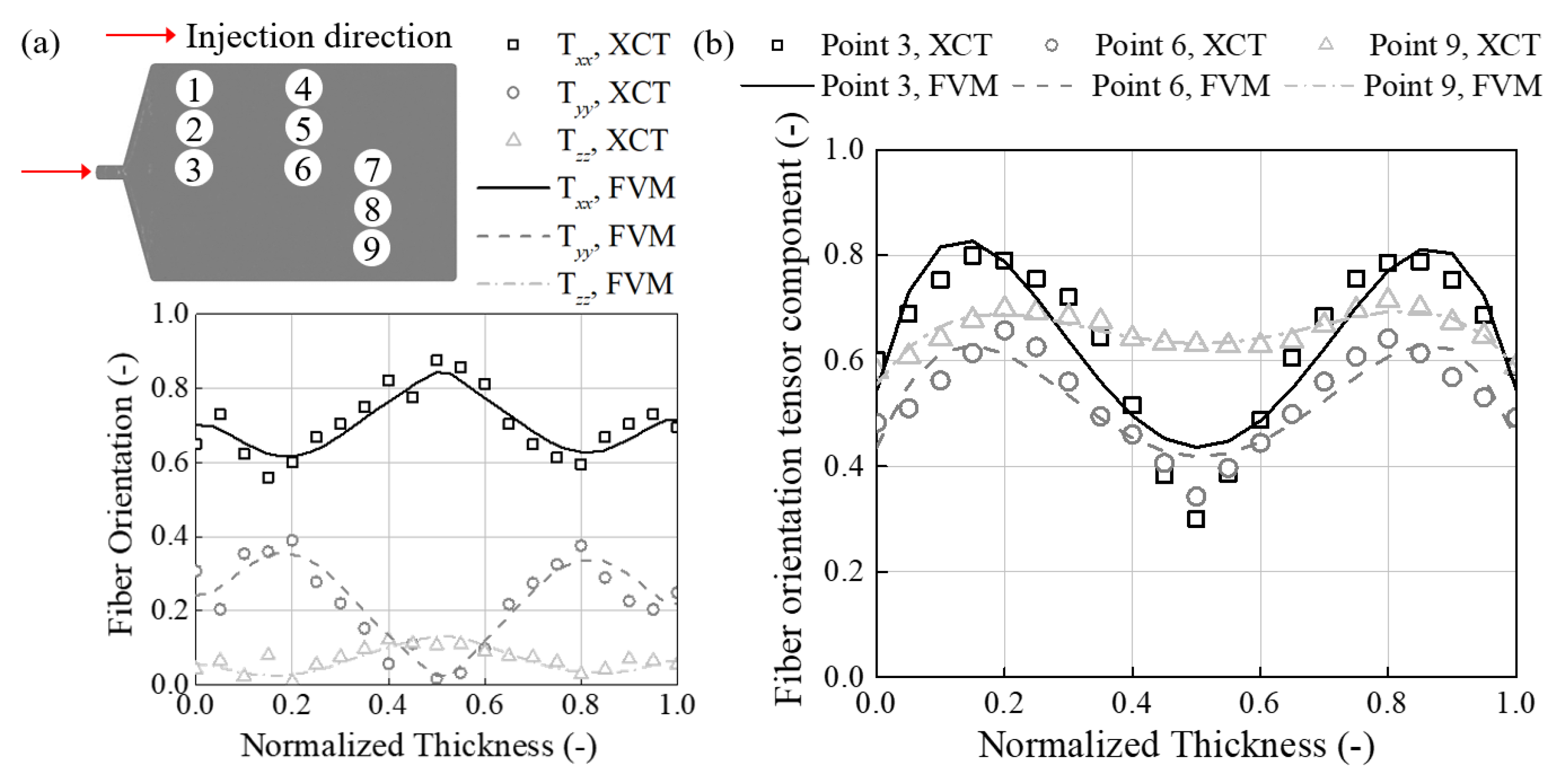
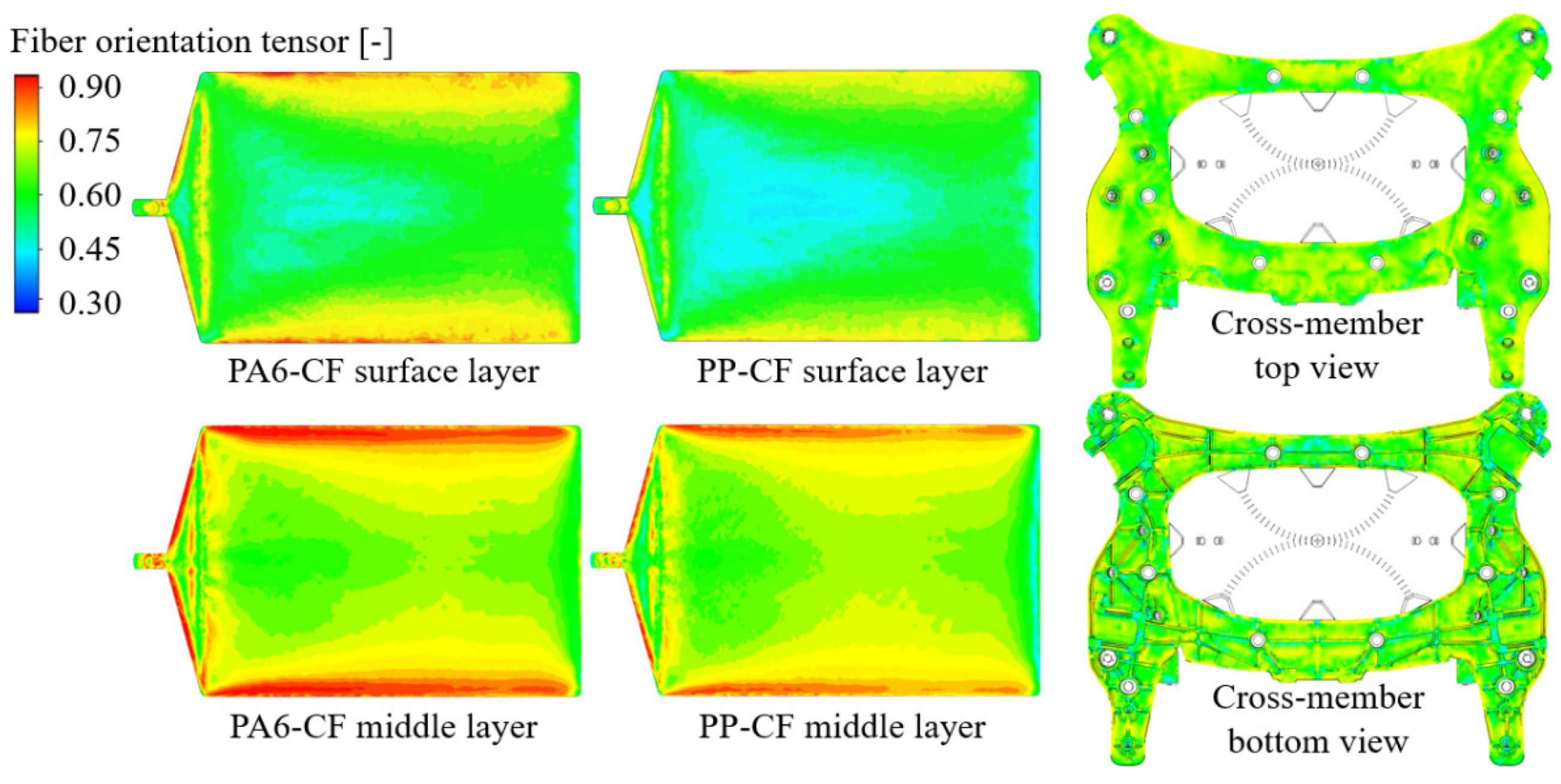
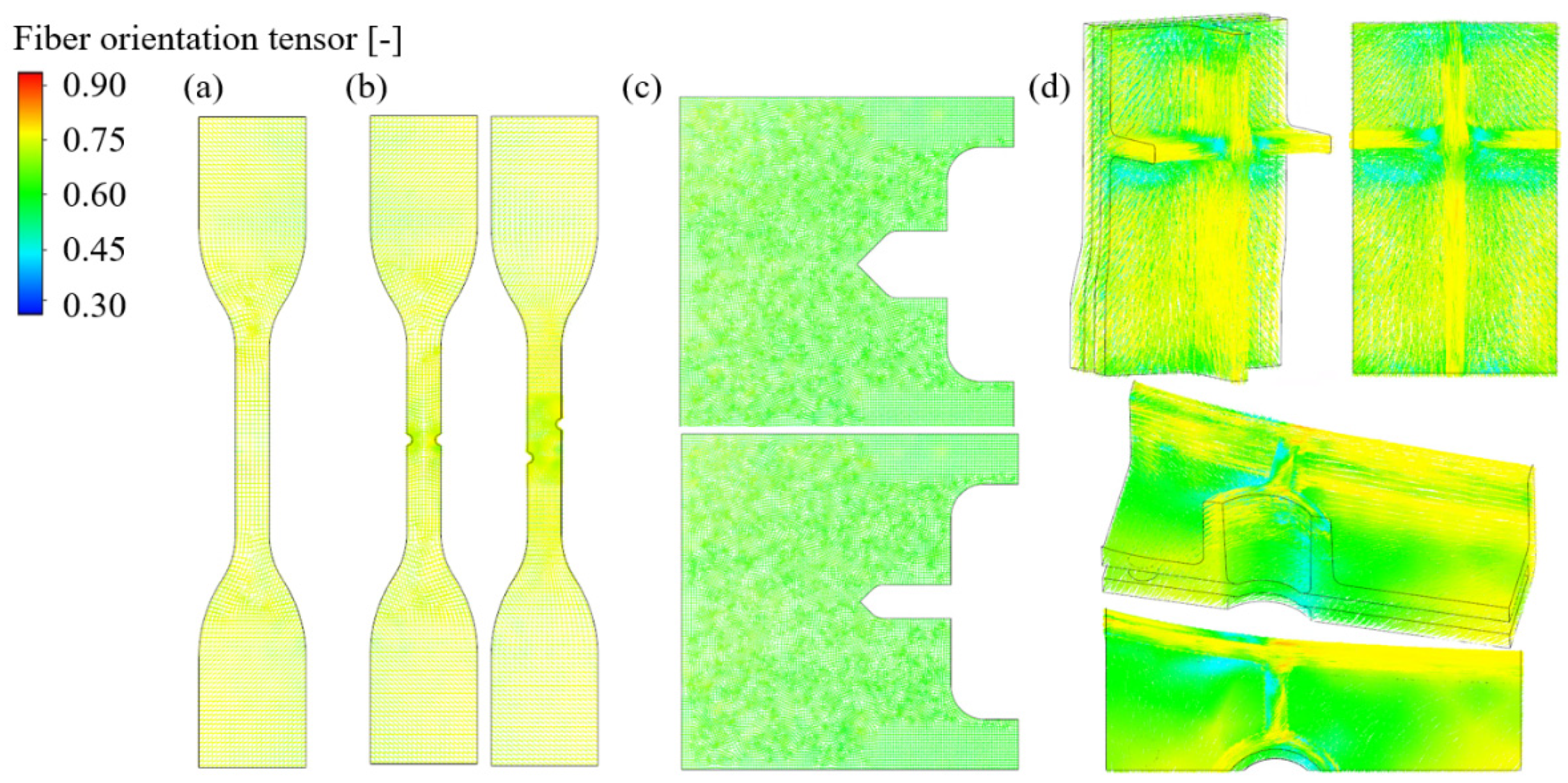

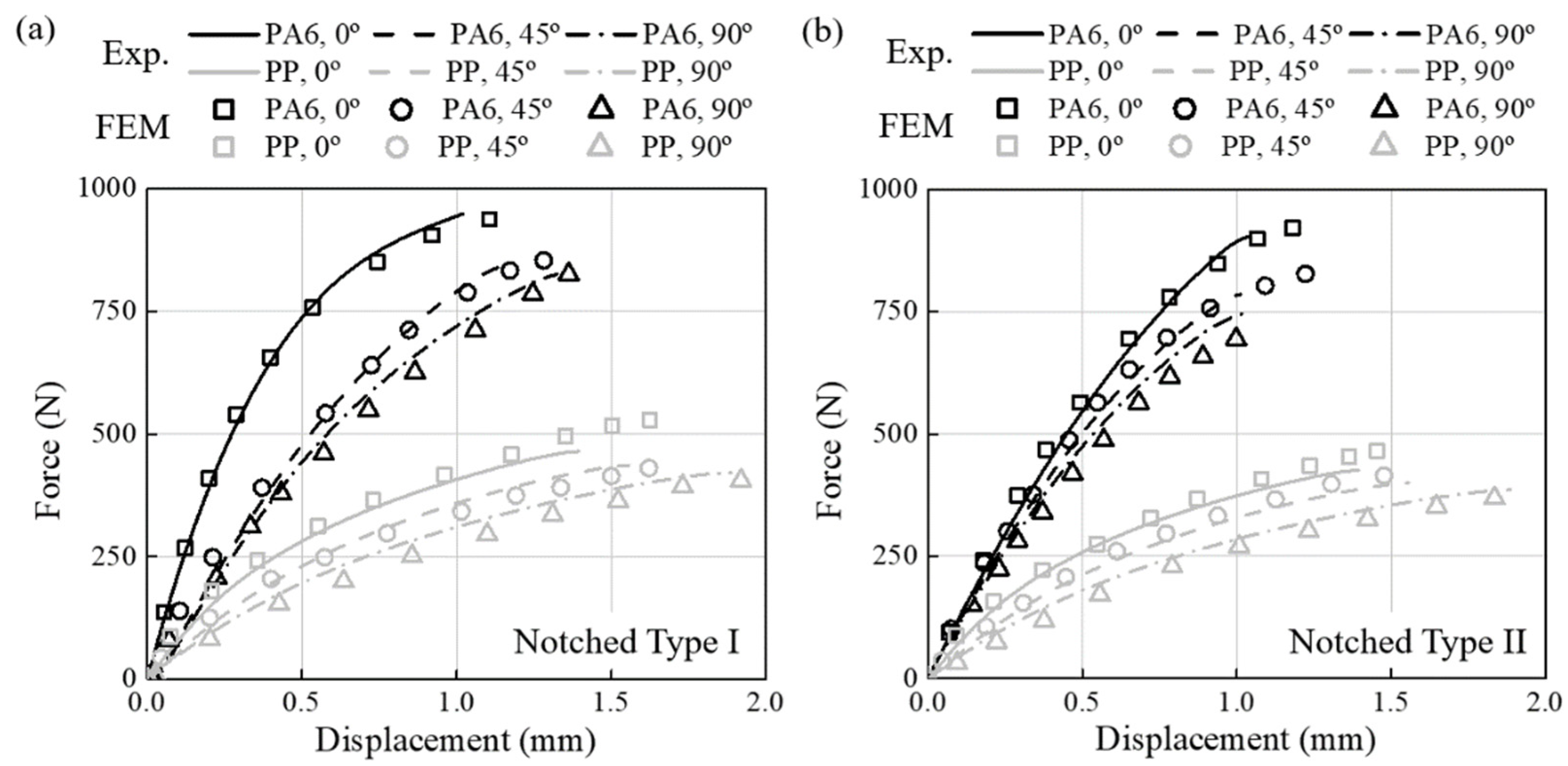
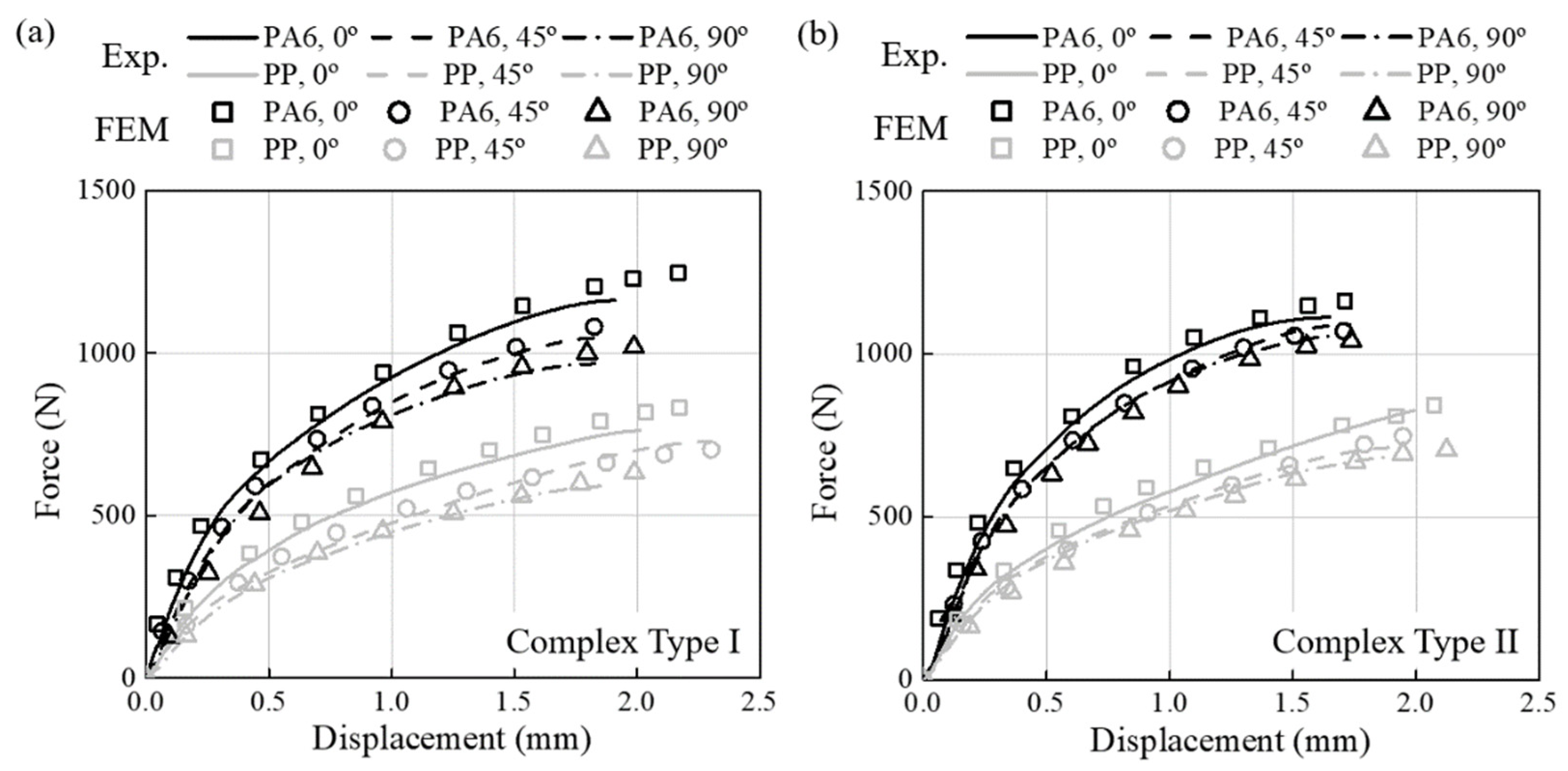
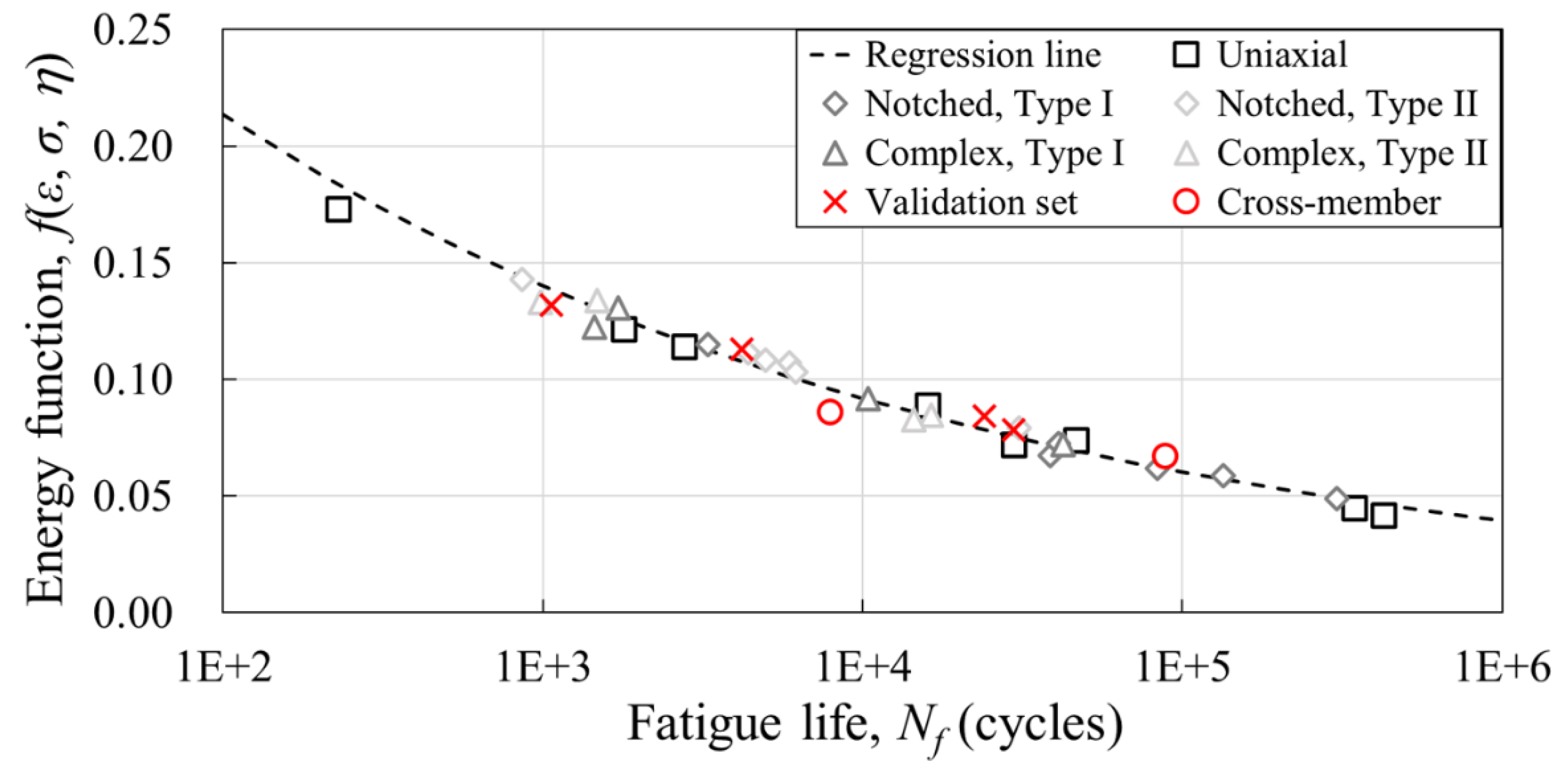
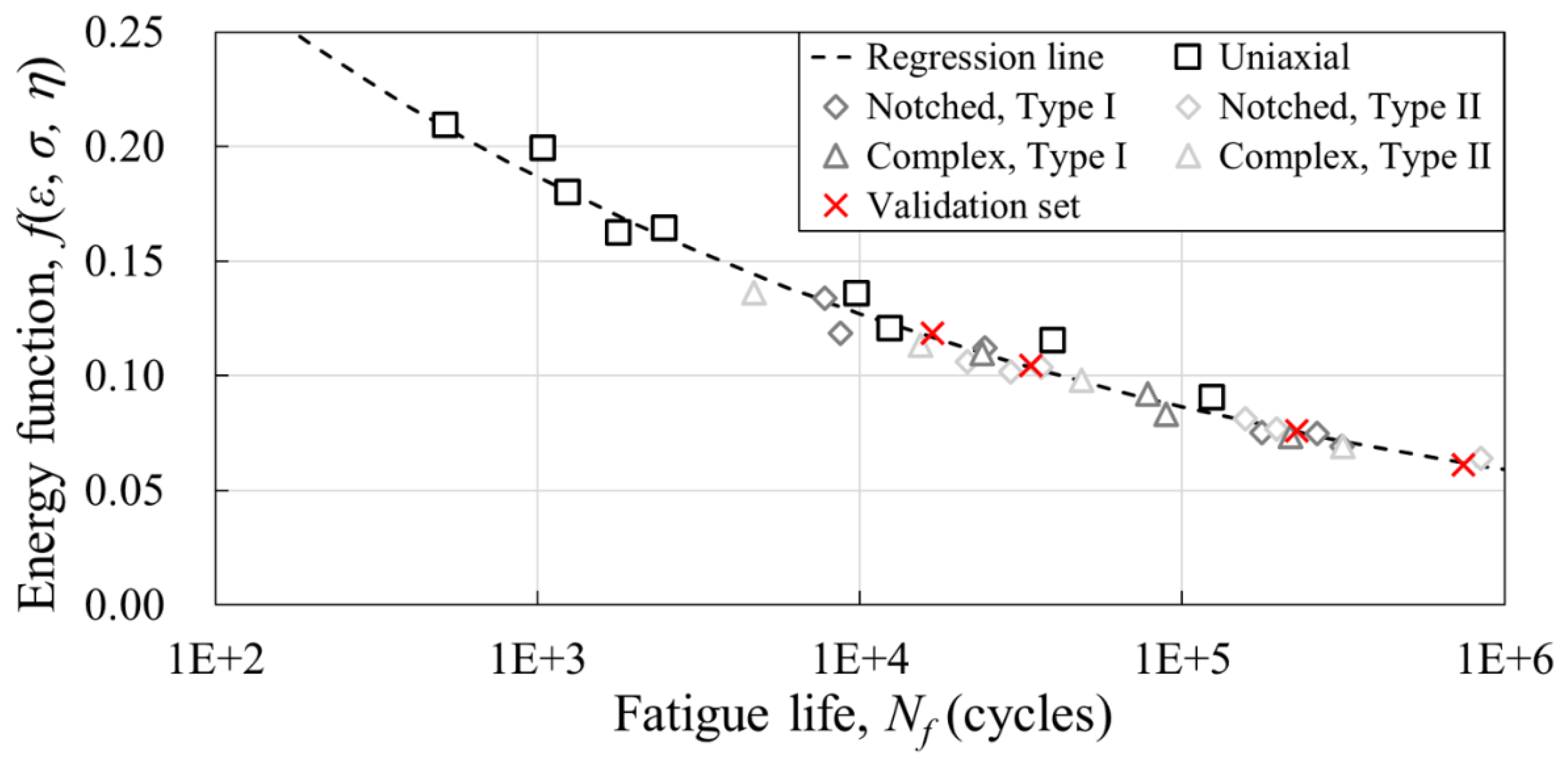
| Process Parameters | Plate | Cross-Member |
|---|---|---|
| Mold surface temperature [°C] | 85 | |
| Melt temperature [°C] | 285 | |
| Switch-over by %volume filled [%] | 99 | |
| Injection time [s] | 2 | 20 |
| Cooling time [s] | 20 | 140 |
| Materials | [MPa] | [−] | [−] | [−] | [−] | [GPa] | [GPa] |
|---|---|---|---|---|---|---|---|
| PA6-CF | 95.07 | 11.56 | 1.77 | 1.14 | 0.85 | 4.92 | 136.57 |
| PP-CF | 18.27 | 12.60 | 2.76 | 1.94 | 0.85 | 1.01 | 82.55 |
| Material | Specimen Angle [°] | TS [MPa] | [GPa] | [−] |
|---|---|---|---|---|
| PA6-CF | 0 | 201.9 | 14.7 | 0.024 |
| 45 | 141.6 | 7.5 | 0.038 | |
| 90 | 125.1 | 6.8 | 0.030 | |
| PP-CF | 0 | 37.2 | 8.3 | 0.027 |
| 45 | 31.1 | 7.1 | 0.032 | |
| 90 | 27.8 | 4.3 | 0.044 |
| Geometry | Triaxiality [] | Specimen Angle [°] | [−] | [−] | [MPa] | [MPa] | Nf [cycles] |
|---|---|---|---|---|---|---|---|
| Uniaxial | 0.333 | 0 | 0.012 | 0.003 | 150.1 | 48.4 | 1800 |
| 0.013 | 0.007 | 157.7 | 103.8 | 46,700 | |||
| 0.017 | 0.007 | 183.1 | 103.8 | 230 | |||
| 45 | 0.011 | 0.004 | 75.1 | 29.0 | >106 | ||
| 0.013 | 0.007 | 92.2 | 58.4 | 428,500 | |||
| 0.017 | 0.007 | 112.5 | 58.4 | 16,100 | |||
| 90 | 0.012 | 0.003 | 80.9 | 25.1 | 29,800 | ||
| 0.013 | 0.007 | 86.8 | 53.5 | 346,900 | |||
| 0.017 | 0.007 | 103.2 | 53.5 | 1790 | |||
| Notched Type I | 0.408 | 0 | 0.116 | 0.087 | 300.2 | 275.8 | 83,400 |
| 0.116 | 0.058 | 300.2 | 227.5 | 38,600 | |||
| 0.475 | 45 | 0.163 | 0.108 | 210.4 | 172.9 | 134,000 | |
| 0.163 | 0.072 | 210.4 | 125.6 | 3280 | |||
| 0.481 | 90 | 0.091 | 0.046 | 184.3 | 106.4 | 41,000 | |
| 0.091 | 0.057 | 184.3 | 128.3 | 304,000 | |||
| Notched Type II | 0.393 | 0 | 0.111 | 0.069 | 288.7 | 210.6 | 30,900 |
| 0.111 | 0.055 | 288.7 | 176.6 | 4400 | |||
| 0.469 | 45 | 0.143 | 0.067 | 223.5 | 164.2 | 4980 | |
| 0.143 | 0.072 | 223.5 | 138.1 | 5900 | |||
| 0.498 | 90 | 0.180 | 0.113 | 228.3 | 163.6 | 6200 | |
| 0.180 | 0.090 | 228.3 | 136.5 | 860 | |||
| Complex Type I | 0.555 | 0 | 0.132 | 0.093 | 266.8 | 228.9 | 10,400 |
| 0.132 | 0.078 | 226.8 | 214.1 | 1720 | |||
| 0.612 | 45 | 0.159 | 0.114 | 238.6 | 207.6 | 29,600 | |
| 0.159 | 0.129 | 230.3 | 187.8 | 1450 | |||
| 0.641 | 90 | 0.215 | 0.158 | 230.3 | 206.5 | 42,300 | |
| 0.215 | 0.129 | 230.3 | 187.8 | 4200 | |||
| Complex Type II | 0.544 | 0 | 0.107 | 0.071 | 268.5 | 233.2 | 16,400 |
| 0.107 | 0.053 | 268.5 | 209.6 | 980 | |||
| 0.602 | 45 | 0.139 | 0.092 | 237.5 | 207.9 | 24,000 | |
| 0.139 | 0.069 | 237.5 | 180.2 | 1480 | |||
| 0.655 | 90 | 0.123 | 0.082 | 206.7 | 176.8 | 14,500 | |
| 0.123 | 0.061 | 206.7 | 151.2 | 1060 | |||
| Location I | 0.529 | - | 0.172 | 0.094 | 198.9 | 122.4 | 88,700 |
| Location II | 0.601 | - | 0.338 | 0.193 | 331.1 | 220.6 | 7960 |
| Geometry | Triaxiality [] | Specimen Angle [°] | [−] | [−] | [MPa] | [MPa] | Nf [Cycles] |
|---|---|---|---|---|---|---|---|
| Uniaxial | 0.333 | 0 | 0.014 | 0.004 | 37.3 | 29.9 | 1780 |
| 0.016 | 0.004 | 37.6 | 29.9 | 1040 | |||
| 0.017 | 0.006 | 37.8 | 32.9 | 520 | |||
| 45 | 0.013 | 0.004 | 30.7 | 23.8 | 9780 | ||
| 0.016 | 0.004 | 31.1 | 23.8 | 1240 | |||
| 0.017 | 0.006 | 31.1 | 27.1 | 2480 | |||
| 90 | 0.013 | 0.004 | 26.8 | 17.3 | 123,800 | ||
| 0.016 | 0.004 | 27.6 | 17.3 | 12,400 | |||
| 0.017 | 0.007 | 28.0 | 21.6 | 39,800 | |||
| Notched Type I | 0.379 | 0 | 0.152 | 0.102 | 161.7 | 131.1 | 262,400 |
| 0.152 | 0.076 | 161.7 | 114.6 | 8700 | |||
| 0.389 | 45 | 0.163 | 0.109 | 147.4 | 122.3 | 312,600 | |
| 0.163 | 0.081 | 147.4 | 104.2 | 24,500 | |||
| 0.404 | 90 | 0.126 | 0.049 | 115.3 | 56.0 | 7800 | |
| 0.126 | 0.078 | 115.3 | 82.2 | 176,400 | |||
| Notched Type II | 0.376 | 0 | 0.121 | 0.073 | 145.3 | 112.6 | 196,000 |
| 0.121 | 0.061 | 145.3 | 100.9 | 29,400 | |||
| 0.421 | 45 | 0.146 | 0.087 | 141.8 | 101.6 | 156,700 | |
| 0.146 | 0.073 | 141.8 | 88.5 | 21,600 | |||
| 0.435 | 90 | 0.145 | 0.100 | 123.6 | 97.1 | 846,200 | |
| 0.145 | 0.078 | 123.6 | 80.0 | 36,500 | |||
| Complex Type I | 0.467 | 0 | 0.137 | 0.082 | 154.3 | 126.3 | 89,500 |
| 0.137 | 0.064 | 154.3 | 110.4 | 16,750 | |||
| 0.481 | 45 | 0.165 | 0.110 | 140.0 | 120.0 | 746,500 | |
| 0.165 | 0.088 | 140.0 | 107.0 | 78,400 | |||
| 0.512 | 90 | 0.213 | 0.142 | 134.9 | 114.2 | 216,500 | |
| 0.213 | 0.113 | 134.9 | 102.0 | 23,900 | |||
| Complex Type II | 0.467 | 0 | 0.134 | 0.089 | 153.0 | 132.4 | 314,500 |
| 0.134 | 0.071 | 153.0 | 119.4 | 34,000 | |||
| 0.479 | 45 | 0.177 | 0.118 | 140.8 | 118.2 | 226,500 | |
| 0.177 | 0.095 | 140.8 | 105.8 | 15,400 | |||
| 0.501 | 90 | 0.156 | 0.094 | 176.2 | 131.5 | 48,600 | |
| 0.156 | 0.073 | 176.2 | 110.2 | 4700 |
| Materials | Geometry | Specimen Angle [°] | Deviation [%] |
|---|---|---|---|
| PA6-CF | Uniaxial | 0 | 1.04 |
| 45 | 2.05 | ||
| 90 | 2.68 | ||
| Notched Type I | 0 | 2.08 | |
| 45 | 2.79 | ||
| 90 | 1.38 | ||
| Notched Type II | 0 | 2.81 | |
| 45 | 2.37 | ||
| 90 | 2.51 | ||
| Complex Type I | 0 | 2.64 | |
| 45 | 2.87 | ||
| 90 | 2.92 | ||
| Complex Type II | 0 | 2.58 | |
| 45 | 1.73 | ||
| 90 | 2.51 | ||
| Cross-member location 1 | - | 2.94 | |
| Cross-member location 2 | - | 3.16 | |
| PP-CF | Uniaxial | 0 | 1.28 |
| 45 | 2.78 | ||
| 90 | 2.64 | ||
| Notched Type I | 0 | 1.13 | |
| 45 | 2.41 | ||
| 90 | 2.95 | ||
| Notched Type II | 0 | 2.43 | |
| 45 | 2.55 | ||
| 90 | 2.89 | ||
| Complex Type I | 0 | 2.42 | |
| 45 | 1.68 | ||
| 90 | 1.27 | ||
| Complex Type II | 0 | 2.61 | |
| 45 | 1.42 | ||
| 90 | 2.88 |
| Materials | [−] | [−] |
|---|---|---|
| PA6-CF | 0.4958 | −0.183 |
| PP-CF | 0.5915 | −0.167 |
Disclaimer/Publisher’s Note: The statements, opinions and data contained in all publications are solely those of the individual author(s) and contributor(s) and not of MDPI and/or the editor(s). MDPI and/or the editor(s) disclaim responsibility for any injury to people or property resulting from any ideas, methods, instructions or products referred to in the content. |
© 2023 by the authors. Licensee MDPI, Basel, Switzerland. This article is an open access article distributed under the terms and conditions of the Creative Commons Attribution (CC BY) license (https://creativecommons.org/licenses/by/4.0/).
Share and Cite
Choi, J.; Lee, H.; Lee, H.; Kim, N. A Methodology to Predict the Fatigue Life under Multi-Axial Loading of Carbon Fiber-Reinforced Polymer Composites Considering Anisotropic Mechanical Behavior. Materials 2023, 16, 1952. https://doi.org/10.3390/ma16051952
Choi J, Lee H, Lee H, Kim N. A Methodology to Predict the Fatigue Life under Multi-Axial Loading of Carbon Fiber-Reinforced Polymer Composites Considering Anisotropic Mechanical Behavior. Materials. 2023; 16(5):1952. https://doi.org/10.3390/ma16051952
Chicago/Turabian StyleChoi, Joeun, Hyungtak Lee, Hyungyil Lee, and Naksoo Kim. 2023. "A Methodology to Predict the Fatigue Life under Multi-Axial Loading of Carbon Fiber-Reinforced Polymer Composites Considering Anisotropic Mechanical Behavior" Materials 16, no. 5: 1952. https://doi.org/10.3390/ma16051952






